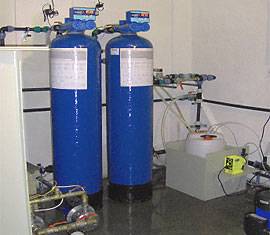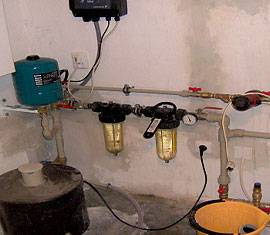Treatment of underground water
Water disinfection via chlorine is carried out by dosing a solution of hypochlorite via a dosing pump managed from the running of the main pump of the treated water. The set is situated in the waterworks building. With respect to the possible use of pumps with different power outputs, the process of calculating the thinning is given below.
Water disinfection
Water disinfection via chlorine is carried out by dosing a solution of hypochlorite via a dosing pump managed from the running of the main pump of the treated water. The set is situated in the waterworks building. With respect to the possible use of pumps with different power outputs, the process of calculating the thinning is given below.
The use of LMI dosing pump
With respect to the possible use of pumps with different power outputs, the process of calculating the thinning is given below. In general, the following applies when determining the amount of hypochlorite dissolved in the dissolving tank:
| Q * ( cp + cv ) * 3.6 = Qd * c * Vx / Vn where: |
|---|
| Q - output of water pump [l/s] |
| cp – required concentration of chlorine in treated water [mg/l] 0,2-0,4 (mg/l) required |
| cv - the actual consumption of chlorine [mg/l] (cca=0-0,3) |
| Qd – the output of the dosing pump [l/hod], i.e. max. output*uplift percentage/100*frequency percentage/100 e.g. 1,7 l/hour * 70/100*50/100=0,595=0,6 l/hour |
| c – concentration of active chlorine in hypochlorite [g/l] (SAVO 50 g/l, hypochlorite 120 g/l) |
| Vx – the volume of dissolved hypochlorite (SAVO) [litres] |
| Vn – the volume of solution in storage tank [litres] |
The dose is approximately 1-5 litres of Savo/40 litres in the tank.
The dose is for reference purposes only, it must be adjusted according to the results of chlorine inspections on the mesh (concentration within the scope of 0,05 - 0,3 mg/l). Recommended setting of uplift and frequency: storke 70 %, speed 70 %. Distilled or demineralized water is used for dissolution.
Description of a disinfecting facility
It is a membrane electromagnetic pump allowing for the setup of the membrane uplift and pulse frequency.
Operation
The size of the dose is set up via a combination of uplift size, frequency and concentration of the disinfecting solution. The uplift size is recommended higher than 0.3 of the minimum. The uplift (storke) can only be set up while the pump is running, in the moment of the pulse. Otherwise, the button on the little shaft glides down and it is necessary to set up zero again; see the original instructions manual. The pump is kept in operation until hypochlorite is spent up to the operational minimum; the tank is washed with water and hypochlorite is added.
Malfunctions
There may be an air lock of the pump in higher surrounding temperatures. We disconnect the hose on the upper valve and start the pump. After the pump’ head is filled, we connect the hose. It is also possible to deaerate the tank by pulling and holding the buttons on the upper valve. Obstruction of the injection unit to the water pipe represents a relatively frequent malfunction (once or twice per year). It is caused by rapid change of water pH after dosing the disinfection, and subsequent formation of scale sediment. Apart from constructional arrangement (elastic band at the end of the injector), no other preventative measures are possible. If the valves or other parts become obstructed, we disassemble the pump’s head and clean it with muriatic acid.
Inspection of disinfection operation
The inspection consists in the control of the function (inspection of eventual leaks) and the measurement of chlorine content in water. The required content of chlorine in the mesh is 0,05-0,3 mg/l; it is carried out colorimetrically in the measurement by a mobile set DPD - Merck. A check-up of DPD-Merck is carried out in order to allow for precise determination. The inspection is recorded in the operational journal.



